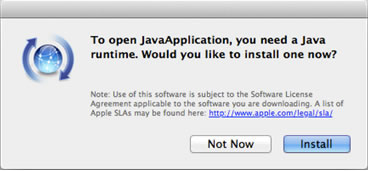

We have two Java installed, so we run the command twice with their locations. To do this, we use the jenv command with add and specify the location of the JDK. We add the Java versions we want to the jenv list. Configure jenv to include the installed Java versions.> echo 'eval "$(jenv init -)"' > ~/.zshrc > echo 'export PATH="$HOME/.jenv/bin:$PATH"' > ~/.zshrc In our case, we use the zsh shell to use the below commands. To use the jenv tool, we need to set the variables with the command shell. Complete the installation by setting the variables to the shell.
#Java runtime environment mac os install
We use the below command to install jenv on the local machine. Install the jenv tool using the Homebrew package management system.The jEnv is a command-line utility that makes the setup of environment variables easy. Java HotSpot(TM) 64-Bit Server VM (build 25.202-b08, mixed mode) Java(TM) SE Runtime Environment (build 1.8.0_202-b08) We use the java -version command to check the current Java version, and when we execute it, the new version returns in the output. Check the Java version again to confirm that the version was changed.> export JAVA_HOME=`/usr/libexec/java_home -v 1.8` Note that backticks are being used around the path. We use the export command with the variable name next to it and then specify the location of usr/libexec/java_home with the argument -v and the version we want to change to 1.8. JAVA_HOME is the variable that sets the system default for Java. Now we change the environment variable JAVA_HOME to a new value. Change the Java version to Java 1.8 version.We can see the default JDK is Java version 14.0.1 if we want to change this version to 1.8, we need to follow the further steps.

Java HotSpot(TM) 64-Bit Server VM (build 14.0.1+7, mixed mode, sharing) Java(TM) SE Runtime Environment (build 14.0.1+7) We use the command java with -version that returns the version of the default JDK. Now, we get the current default Java version used in the mac.The first Java version is 14.0.1, while the second Java version is 1.8. We can see three versions of Java available we focus on the first and the last Java version. Here is the output after running the command. java_home command with -V that returns the versions and locations of the installed Java. Once we are in the /usr/libexec directory, we execute the. Check all the installed Java versions on the local mac.įirst, we need to change the current directory to /usr/libexec using the cd command.In the following steps, we will change the value of the default Java environment variable using the command line. This environment variable is where we tell the version of Java to be used as default. When installing the JDK package on our mac, we have to specify its path as an environment variable to access the Java tool anywhere in the local system. Use the Traditional Way to Change Java Version in MacOS When multiple Java installations of different versions are available on the local machine, we can switch between them using the following steps.
#Java runtime environment mac os how to
In this article, we will discuss how to change the version of Java installed on a mac machine.


 0 kommentar(er)
0 kommentar(er)
